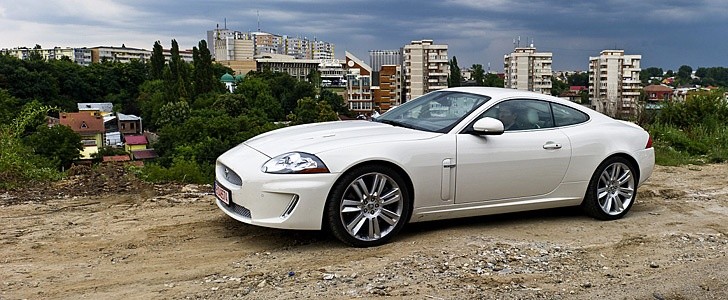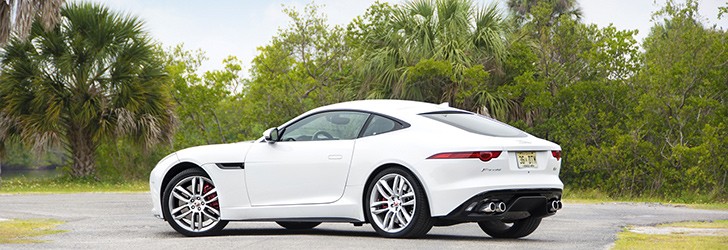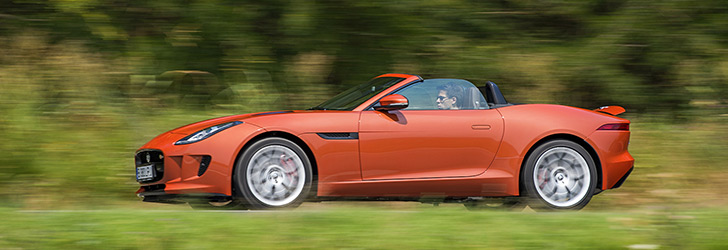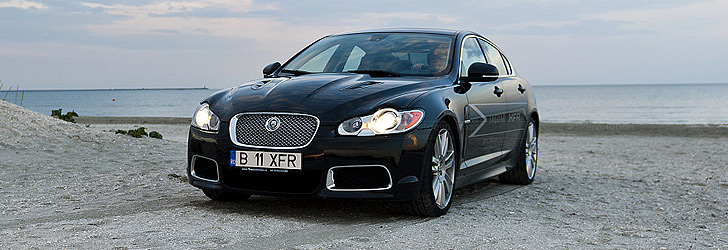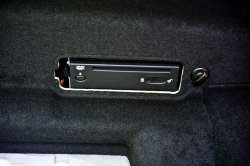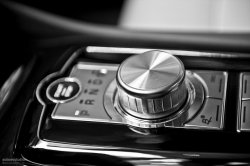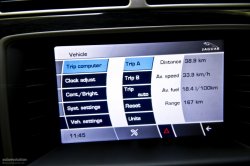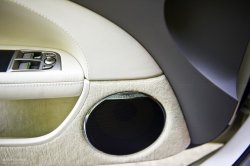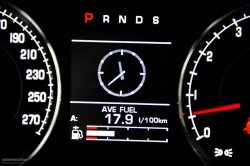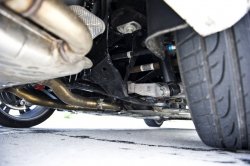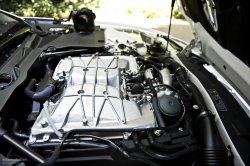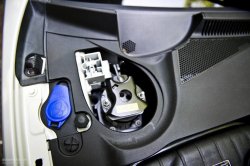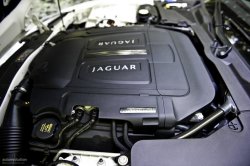JAGUAR XKR Review
OUR TEST CAR: JAGUAR XKR
It’s 1948 and Jaguar has moved on to the post-war era, introducing important changes to its core values, as the company decided to make one step from the pedestal it had been on to the real world. No, of course Jag hadn’t reduced the intensity of its shining, it just decided to make it wider, offering it to a wider category of mortals.
For example, the company, which had been named “SS Cars” before the war, decided to change its name to the current one, due to the negative connotations that these two letters had been given by WWII. But let’s see how this was translated into the vehicles it produced.
The carmaker’s first sports car that played by these new rules was also the first XK, the 120. And this gentleman was also a proper athlete. You see, its top speed of 120 mph/193 km/h (hence its name) might be available in your average family car today but back then it made the XK120 the fastest standard production car in the world.
The hero’s successor, the XK140, arrived in 1954, offering improvements in multiple areas. However, it didn’t rest on its father’s laurels, having something of its own to offer to the world - it was the first Jaguar sports car to use an automatic transmission.
In 1957, Jaguar gave us the XK150, a natural evolution. Enjoying your leather-covered dashboard in your contemporary Jag? well, the XK150 was the one to replace the walnut dash with this type of finish.
Our hands seem to wish to close the text editor and open a music production app in order to create tension, as we are about to mention a moment that (re)defined Jaguar’s history. 1961 was the year when the Brits rocked the world with the roar, introducing the E-Type, a vehicle that became one of the greatest motoring icons of all times. This is a vehicle that could fill an online library alone and thus we decided that it deserves more than just words. What did we do to celebrate its 50th anniversary? You’ll find the answer hidden in the review’s conclusions.
The E-Type was replaced by the XJS in 1975. It wasn’t as performance-orientated as the E-Type, but boasting a GT character instead. The new model set the modern foundation for Jaguar’s future developments, with certain guidelines introduced by it still being with us today.
Jaguar subsequently concentrated its efforts on offering GT that would make very few compromises and wanted everybody to know this. Thus, the XK nameplate was brought back to life in 1996, with the new XK Coupe and Convertible (internal name X100). As an interesting fact, both the XK and the Aston Martin DB7, one of its main rivals, were underpinned by a heavily modified Jaguar XJS platform.
In 2006, Jaguar wrote a new chapter in this (hi)story, introducing a new XK, which had been previewed by the Advanced Lightweight Coupe Concept one year before. Codenamed XK150, the fresh Coupe and Convertible brought back an old passion of the carmaker - the aluminum body.
In 2009, Jaguar introduced the kind of facelift that we love here at autoevolution - one that is focused on the tech side. Thus, the XK range was fitted with a new 5.0-liter engine, which can be found in a naturally aspirated (XK) or supercharged incarnation (XKR).
This is the point where we enter the stage, as we’ve recently testdriven played driven the XKR in the quest to find another car that should be included in our dream garage.
Please, make yourself at home in the armchair-like seat, as we will immediately start our journey...
The XKR is the kind of car that makes your day when you look at it before you set off in the morning. It’s like Rachel Weisz. It doesn’t matter if she’s smiling at you while wearing pajamas or if she winks while redefining the notion of “little black dress” during a high class event - the sheer look will instantly change your mood, no matter how cold-blooded you are. And when you think that it uses an aluminum construction, things become even more interesting.
While the addition of the “R” badge to the XF has brought sporty elements that are interesting but can still be spotted as additions on the XKR, every visual go-fast element seems to have been there from the inception. This is true for the air vents on the bonnet, the 20-inch lightweight alloy rims, which instantly brought the notion of airflow cooling the brakes to our mind, well, like we said, everything.
Our test car was finished in Porcelain White, a color that we would’ve never chosen as it seems to give it the appearance of a car created for customers who are anyway but young, but this didn’t actually matter.
Dare to look this feline in the eyes and you’ll feel the aggression that lies inside. In fact, this is one of the design’s main assets - the fact that it dissimulates aggression so well, while still allowing you to perceive enough of it to respect this car profoundly.
And the hood, oh that hood.... It just happens to be long and to have the hinges placed at the front, so the E-Type instantly comes to mind. And speaking of the E-Type, we have to mention the front grille, which is so strongly connected to that of the motoring icon. We didn’t know that being haunted by a ghost from the past can be so sweet.
One of the most important exterior elements brought by the 2009 facelift is a pair of LED headlights that act like painkillers. Let us explain: you will harm other drivers’ egos as you overtake them, but the sight of the headlights, especially at dusk or at night, which is like making eye contact with Rachel, will heal the pain. Don’t want to be so nice? just step on the gas and the audio assault will paralyze your victim.
If we were to use virtual reality to divide the XKR into an animated multi-character story and organize a race, the interior would come last. The cabin doesn’t really manage to raise up to the standard of the car. Don’t get us wrong, it’s not an Achilles’ Heel, this would have been unforgivable in a GT, but we just wish certain things would be improved.
The front seats just make you wish you could take them home. We are talking about 10-way electric adjustable seats that offer heating and cooling functions. One adjustment that we particularly enjoyed was that of the lateral support - by turning a little knob on the majestic controls located on the door, you can adjust the way in which the seat hugs you.
The vehicle we tested came with a Soft Grain Ivory/Oyster interior finish, which relaxed you from the first seconds of sitting inside the car. There’s no use to talk about the room in the back - an adult just won’t fit and neither will a child, if he’s already in school.
However, this is more generous that in other coupes, so it does offer a pleasing sensation. As for the room in the front, this is decent, but for such an excellent GT we would’ve liked it to be a bit more generous.
The center console seems to have just the right amount of buttons, of course including the spectacular cylindrical gear selector everybody talks about.
As you are welcomed in the driver’s seat, your attention is instantly drawn by the instrument panel. The speedometer and the rev counter seem to have been crafted by a designer that usually handles mechanical watches.
The driving position is just like the car: conformable when you want it to and sporty when you need it to. Of course, you never get a 100 percent focus, but this is not the idea here.
The luggage compartment was hungry enough to serve all out usual test drive “accessories”, so we did’t have to turn to the back seats to have our luggage needs catered to. You just open the hatch, amuse yourself for a second seeing the sign that’s warning you not to scalp a hypothetical rear passenger when closing it back and the job is done.
The vehicle we tested was also fitted with an Alcantara headliner, which made it resemble to a woman even stronger.
You take a quick look at the car as you approach it and say to yourself “Yes, she’s a beauty, but this must come at a cost”. You are right, but the visibility isn’t included in this toll. We weren’t too worried about the front one, but even the rear one is OK. But there’s more: everytime you look in the exterior rear view mirrors, you see those wide hips which bring a smile to your mind.
Hello there fellow urban travelers, this is the autoevolution test drive team speaking from inside the Jaguar XKR. We’re not sure that just telling you that the XKR isn’t as city-unfriendly as you thought can cut it, so we’ll spend some time away from the car to explain this.
Let’s start with a nice fact: Jaguar’s engineers made the car in such a way that you don’t have to trade parking agility in exchange for good high-speed handling, like you do in many performance vehicles. Oh, no. The XKR comes with a turning radius of 10.8 meters, so maneuvering the 4,8 m beast through the urban landscape won’t be an issue, even though the 2.02 m width does mean that you have to be pretty careful if you fancy swift maneuvers at rush hours.
We said the visibility is OK, but if you had to rely solely on it to park you’d still be a dead man. Fortunately, the front & rear parking sensors are well calibrated and allow you to spare the sweaty moments. However, we lusted for the rearview camera the XFR treated us with.
Shopping? No problem, the boot has 330 liters ready for you and, unlike in many coupes, where the opening is too shy, here you have all the space in the world. In fact, it’s a bit too large, so you have to be careful when you place a hefty object inside the trunk.
The ride, even with the 20-inch wheels, is comfortable enough to allow you to use the car for everyday driving. The vehicle asks for 18 liters of fuel in return for GT-ing you around 100 km of urban roads (13 mpg), which is an acceptable value for this level of performance.
Unless you leave in Monaco and have friends with high positions in the city’s administration, you won’t be able to use the powerplant’s resources inside the city, but duality of the XKR means that you’ll enjoy every second of first quarter-throttle urban transportation.
You will draw a lot of attention, regardless of the color you choose for your XKR, so be prepared to have a large number on eyes on you at all times.
The start button fills the entire room with a sound that seems to be coming from the depths of the ground. Soon everything around you becomes blurry and as the sound reverbs from the trees on the side of the road, you just want to push the pedal on the right harder and harder.
You hit the electronic speed limiter and experience the feeling you get when you’re in an aircraft that enters the clouds. What’s happening? You’re in a Jaguar XKR at full speed, doing 155 mph/ 250 km/h (theoretically, as we managed to hit 174 mph/ 280 km/h, even though our test car wasn’t fitted with the optional speed package, which should allow you to trade the first value on the latter).
As you enter the tunnel, you brake violently and then floor the throttle again. The gearbox goes from sixth to fourth and stays there until the engine hits the red line - you feel like you’re riding a wave of thunder.
On the other side of the mountain, you encounter a stunning landscape. You are bewildered and take the foot off the throttle so sudden that the engine brakes almost hurt you. You’re still in sixth gear, but this time the revs are pretty close to idling. Your brains starts playing with sensations, switching the focus between the soft touch of the leather and the rich landscape you see in the distance. Congratulations, you’ve just met the XKR’s effortless mile-eating side.
You just can’t describe this car using just one asset. Or maybe you can: it has to be its duality. In fact, the XKR didn’t invent this - it should be in the nature of every GT, but not all manage to balance performance and waftability so well.
When you put the stability control in “Track” mode and use the Dynamic mode, the throttle response is razor-sharp, the car is committed when it turns in, and you can figure what both axles are going to do next pretty well. If you’re looking to use the driver’s seat with a helmet on, you can give the transmission a few hard times, but only on rare occasions, as it manages to cope with most of your demands. Overtaking takes you back to your first years of life - it’s just like a child’s play.
As for the brakes, all we can say that you’ll probably reach the physical limits of your body before you enter the area where they start to fade. The stopping power? It matches the “go”.
Crossing the road to the other side, we are amazed by how well a suspension, albeit with active dampers, that can tell you where the car is going when you’ve completely stripped the car of its stability control (the process is like a strip tease, as you have to press the button for 15 seconds), manages to handle so many caprices of the road.
The suspension really knows how to make friends: while it works with the clever diff to keep you on the road, it also joins forces with the seats to keep you... happy.
Driving this car in a calm manner (which really doesn’t mean you have to drop the speed too much) is so relaxing that we almost mistook the accelerator pedal for a massage chair remote control.
In case you were wondering, the XFR and the XKR don’t seem to offer the same overall value, as the balance is tipped a little towards the latter. It’s simple: the coupe gains more points for the extra dynamics than the ones lost for the slightly inferior comfort.
For example, the company, which had been named “SS Cars” before the war, decided to change its name to the current one, due to the negative connotations that these two letters had been given by WWII. But let’s see how this was translated into the vehicles it produced.
The carmaker’s first sports car that played by these new rules was also the first XK, the 120. And this gentleman was also a proper athlete. You see, its top speed of 120 mph/193 km/h (hence its name) might be available in your average family car today but back then it made the XK120 the fastest standard production car in the world.
The hero’s successor, the XK140, arrived in 1954, offering improvements in multiple areas. However, it didn’t rest on its father’s laurels, having something of its own to offer to the world - it was the first Jaguar sports car to use an automatic transmission.
In 1957, Jaguar gave us the XK150, a natural evolution. Enjoying your leather-covered dashboard in your contemporary Jag? well, the XK150 was the one to replace the walnut dash with this type of finish.
Our hands seem to wish to close the text editor and open a music production app in order to create tension, as we are about to mention a moment that (re)defined Jaguar’s history. 1961 was the year when the Brits rocked the world with the roar, introducing the E-Type, a vehicle that became one of the greatest motoring icons of all times. This is a vehicle that could fill an online library alone and thus we decided that it deserves more than just words. What did we do to celebrate its 50th anniversary? You’ll find the answer hidden in the review’s conclusions.
The E-Type was replaced by the XJS in 1975. It wasn’t as performance-orientated as the E-Type, but boasting a GT character instead. The new model set the modern foundation for Jaguar’s future developments, with certain guidelines introduced by it still being with us today.
Jaguar subsequently concentrated its efforts on offering GT that would make very few compromises and wanted everybody to know this. Thus, the XK nameplate was brought back to life in 1996, with the new XK Coupe and Convertible (internal name X100). As an interesting fact, both the XK and the Aston Martin DB7, one of its main rivals, were underpinned by a heavily modified Jaguar XJS platform.
In 2006, Jaguar wrote a new chapter in this (hi)story, introducing a new XK, which had been previewed by the Advanced Lightweight Coupe Concept one year before. Codenamed XK150, the fresh Coupe and Convertible brought back an old passion of the carmaker - the aluminum body.
In 2009, Jaguar introduced the kind of facelift that we love here at autoevolution - one that is focused on the tech side. Thus, the XK range was fitted with a new 5.0-liter engine, which can be found in a naturally aspirated (XK) or supercharged incarnation (XKR).
This is the point where we enter the stage, as we’ve recently test
Please, make yourself at home in the armchair-like seat, as we will immediately start our journey...
The XKR is the kind of car that makes your day when you look at it before you set off in the morning. It’s like Rachel Weisz. It doesn’t matter if she’s smiling at you while wearing pajamas or if she winks while redefining the notion of “little black dress” during a high class event - the sheer look will instantly change your mood, no matter how cold-blooded you are. And when you think that it uses an aluminum construction, things become even more interesting.
While the addition of the “R” badge to the XF has brought sporty elements that are interesting but can still be spotted as additions on the XKR, every visual go-fast element seems to have been there from the inception. This is true for the air vents on the bonnet, the 20-inch lightweight alloy rims, which instantly brought the notion of airflow cooling the brakes to our mind, well, like we said, everything.
Our test car was finished in Porcelain White, a color that we would’ve never chosen as it seems to give it the appearance of a car created for customers who are anyway but young, but this didn’t actually matter.
Dare to look this feline in the eyes and you’ll feel the aggression that lies inside. In fact, this is one of the design’s main assets - the fact that it dissimulates aggression so well, while still allowing you to perceive enough of it to respect this car profoundly.
And the hood, oh that hood.... It just happens to be long and to have the hinges placed at the front, so the E-Type instantly comes to mind. And speaking of the E-Type, we have to mention the front grille, which is so strongly connected to that of the motoring icon. We didn’t know that being haunted by a ghost from the past can be so sweet.
One of the most important exterior elements brought by the 2009 facelift is a pair of LED headlights that act like painkillers. Let us explain: you will harm other drivers’ egos as you overtake them, but the sight of the headlights, especially at dusk or at night, which is like making eye contact with Rachel, will heal the pain. Don’t want to be so nice? just step on the gas and the audio assault will paralyze your victim.
If we were to use virtual reality to divide the XKR into an animated multi-character story and organize a race, the interior would come last. The cabin doesn’t really manage to raise up to the standard of the car. Don’t get us wrong, it’s not an Achilles’ Heel, this would have been unforgivable in a GT, but we just wish certain things would be improved.
The front seats just make you wish you could take them home. We are talking about 10-way electric adjustable seats that offer heating and cooling functions. One adjustment that we particularly enjoyed was that of the lateral support - by turning a little knob on the majestic controls located on the door, you can adjust the way in which the seat hugs you.
The vehicle we tested came with a Soft Grain Ivory/Oyster interior finish, which relaxed you from the first seconds of sitting inside the car. There’s no use to talk about the room in the back - an adult just won’t fit and neither will a child, if he’s already in school.
However, this is more generous that in other coupes, so it does offer a pleasing sensation. As for the room in the front, this is decent, but for such an excellent GT we would’ve liked it to be a bit more generous.
The center console seems to have just the right amount of buttons, of course including the spectacular cylindrical gear selector everybody talks about.
As you are welcomed in the driver’s seat, your attention is instantly drawn by the instrument panel. The speedometer and the rev counter seem to have been crafted by a designer that usually handles mechanical watches.
The driving position is just like the car: conformable when you want it to and sporty when you need it to. Of course, you never get a 100 percent focus, but this is not the idea here.
The luggage compartment was hungry enough to serve all out usual test drive “accessories”, so we did’t have to turn to the back seats to have our luggage needs catered to. You just open the hatch, amuse yourself for a second seeing the sign that’s warning you not to scalp a hypothetical rear passenger when closing it back and the job is done.
The vehicle we tested was also fitted with an Alcantara headliner, which made it resemble to a woman even stronger.
You take a quick look at the car as you approach it and say to yourself “Yes, she’s a beauty, but this must come at a cost”. You are right, but the visibility isn’t included in this toll. We weren’t too worried about the front one, but even the rear one is OK. But there’s more: everytime you look in the exterior rear view mirrors, you see those wide hips which bring a smile to your mind.
Hello there fellow urban travelers, this is the autoevolution test drive team speaking from inside the Jaguar XKR. We’re not sure that just telling you that the XKR isn’t as city-unfriendly as you thought can cut it, so we’ll spend some time away from the car to explain this.
Let’s start with a nice fact: Jaguar’s engineers made the car in such a way that you don’t have to trade parking agility in exchange for good high-speed handling, like you do in many performance vehicles. Oh, no. The XKR comes with a turning radius of 10.8 meters, so maneuvering the 4,8 m beast through the urban landscape won’t be an issue, even though the 2.02 m width does mean that you have to be pretty careful if you fancy swift maneuvers at rush hours.
We said the visibility is OK, but if you had to rely solely on it to park you’d still be a dead man. Fortunately, the front & rear parking sensors are well calibrated and allow you to spare the sweaty moments. However, we lusted for the rearview camera the XFR treated us with.
Shopping? No problem, the boot has 330 liters ready for you and, unlike in many coupes, where the opening is too shy, here you have all the space in the world. In fact, it’s a bit too large, so you have to be careful when you place a hefty object inside the trunk.
The ride, even with the 20-inch wheels, is comfortable enough to allow you to use the car for everyday driving. The vehicle asks for 18 liters of fuel in return for GT-ing you around 100 km of urban roads (13 mpg), which is an acceptable value for this level of performance.
Unless you leave in Monaco and have friends with high positions in the city’s administration, you won’t be able to use the powerplant’s resources inside the city, but duality of the XKR means that you’ll enjoy every second of first quarter-throttle urban transportation.
You will draw a lot of attention, regardless of the color you choose for your XKR, so be prepared to have a large number on eyes on you at all times.
The start button fills the entire room with a sound that seems to be coming from the depths of the ground. Soon everything around you becomes blurry and as the sound reverbs from the trees on the side of the road, you just want to push the pedal on the right harder and harder.
You hit the electronic speed limiter and experience the feeling you get when you’re in an aircraft that enters the clouds. What’s happening? You’re in a Jaguar XKR at full speed, doing 155 mph/ 250 km/h (theoretically, as we managed to hit 174 mph/ 280 km/h, even though our test car wasn’t fitted with the optional speed package, which should allow you to trade the first value on the latter).
As you enter the tunnel, you brake violently and then floor the throttle again. The gearbox goes from sixth to fourth and stays there until the engine hits the red line - you feel like you’re riding a wave of thunder.
On the other side of the mountain, you encounter a stunning landscape. You are bewildered and take the foot off the throttle so sudden that the engine brakes almost hurt you. You’re still in sixth gear, but this time the revs are pretty close to idling. Your brains starts playing with sensations, switching the focus between the soft touch of the leather and the rich landscape you see in the distance. Congratulations, you’ve just met the XKR’s effortless mile-eating side.
You just can’t describe this car using just one asset. Or maybe you can: it has to be its duality. In fact, the XKR didn’t invent this - it should be in the nature of every GT, but not all manage to balance performance and waftability so well.
When you put the stability control in “Track” mode and use the Dynamic mode, the throttle response is razor-sharp, the car is committed when it turns in, and you can figure what both axles are going to do next pretty well. If you’re looking to use the driver’s seat with a helmet on, you can give the transmission a few hard times, but only on rare occasions, as it manages to cope with most of your demands. Overtaking takes you back to your first years of life - it’s just like a child’s play.
As for the brakes, all we can say that you’ll probably reach the physical limits of your body before you enter the area where they start to fade. The stopping power? It matches the “go”.
Crossing the road to the other side, we are amazed by how well a suspension, albeit with active dampers, that can tell you where the car is going when you’ve completely stripped the car of its stability control (the process is like a strip tease, as you have to press the button for 15 seconds), manages to handle so many caprices of the road.
The suspension really knows how to make friends: while it works with the clever diff to keep you on the road, it also joins forces with the seats to keep you... happy.
Driving this car in a calm manner (which really doesn’t mean you have to drop the speed too much) is so relaxing that we almost mistook the accelerator pedal for a massage chair remote control.
In case you were wondering, the XFR and the XKR don’t seem to offer the same overall value, as the balance is tipped a little towards the latter. It’s simple: the coupe gains more points for the extra dynamics than the ones lost for the slightly inferior comfort.
12
Our JAGUAR Testdrives:
Photo gallery (115)
